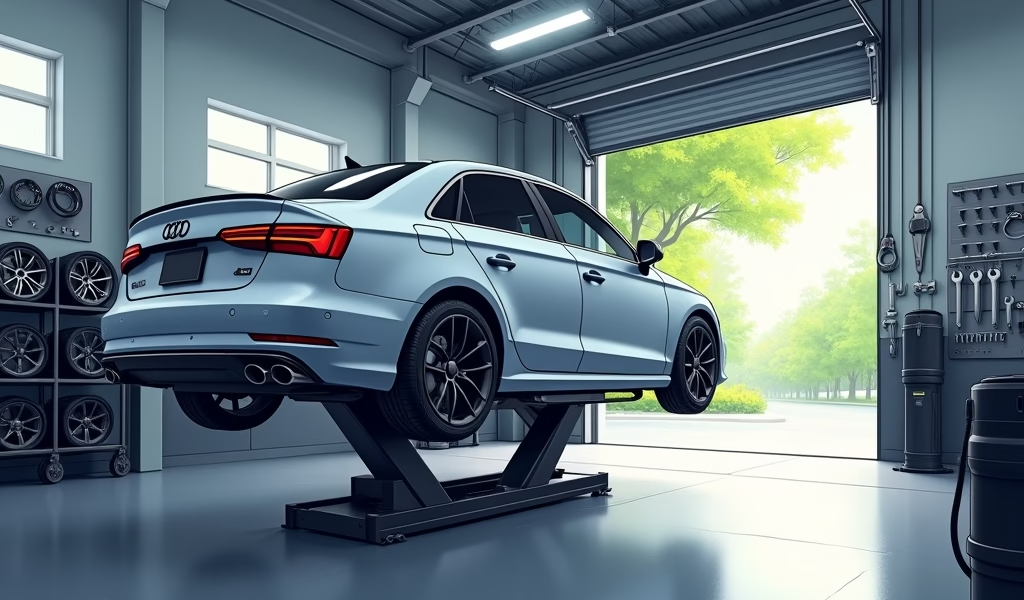Overview
Winter tires should never be used in summer as they wear three times faster in hot conditions, compromise safety with longer stopping distances, and actually cost more in the long run despite seeming economical. The article recommends removing winter tires when temperatures consistently stay above 45°F for seven consecutive days, proper storage in cool dry places, and emphasizes that the minor inconvenience of seasonal tire changes delivers significant safety benefits and financial savings.
Table of Contents
- Understanding Winter Tires: Why They’re Different
- The Dangers of Running Winter Tires in Summer Heat
- How Winter Tires Perform on Hot Pavement
- Proper Storage Tips for Your Winter Tires
- Transitioning Between Seasons: When to Swap
- The Financial Impact of Using Winter Tires Year-Round
- Conclusion
- Frequently Asked Questions
Last week, a customer rolled into my shop with severely worn winter tires in the middle of July. When I asked him how long he’d been driving on them, he sheepishly admitted, “Since last December.” His tires were practically bald in the center! This is exactly why I’m passionate about helping drivers understand the importance of using the right tires for the right season. Winter tires in summer aren’t just a bad idea – they can be downright dangerous and costly.
Having spent over 20 years as a professional mechanic, I’ve seen firsthand what happens when drivers keep their winter tires on year-round. In this comprehensive guide, I’ll share essential knowledge about why winter tires and summer heat don’t mix, plus practical advice on proper storage, transition timing, and how to maximize both safety and the lifespan of your tires.
Understanding Winter Tires: Why They’re Different
Have you ever wondered what makes winter tires so special? It’s not just marketing – the science behind them is fascinating. Winter tires are engineered with specific compounds and tread patterns that perform brilliantly in cold temperatures but suffer dramatically when the mercury rises.
Winter tire rubber compounds contain higher percentages of natural rubber and silica, which keep them flexible at freezing temperatures. According to a study by Tire Rack, winter tires are designed to remain pliable down to -40°F, while summer compounds start losing elasticity below 45°F. This same flexibility becomes a major liability once temperatures climb above 45°F.
The tread patterns tell another part of the story. Those deep grooves, aggressive blocks, and countless tiny slits (called sipes) that bite into snow and ice create more friction and road contact in summer conditions. This leads to something I call the “marshmallow effect” – where your tires feel squishy and unresponsive during warm weather driving.
I remember testing different tire types on our shop’s vehicle several years ago. The difference in handling between winter tires and summer tires at 85°F was shocking – emergency stopping distances were nearly 20% longer with the winter set. That’s the difference between stopping safely and hitting an obstacle.
The Dangers of Running Winter Tires in Summer Heat
Using winter tires during hot weather isn’t just suboptimal – it creates genuine safety concerns that every driver should understand.

First, there’s the acceleration of wear. The softer compounds in winter tires literally melt away on hot asphalt. I’ve measured wear rates up to three times faster when winter tires are used in summer conditions. This doesn’t just mean replacing tires sooner – it means you’ll be driving on dangerously worn tires before you realize it.
Another critical issue is handling stability. Winter tires have tread blocks that squirm and flex on hot roads, reducing your vehicle’s cornering ability and increasing stopping distances. In an emergency maneuver, this could be the difference between avoiding an accident and being involved in one.
The risk of blowouts also increases dramatically. According to data from the National Highway Traffic Safety Administration, tire failures contribute to approximately 11,000 crashes annually, with many occurring during summer months due to heat-related issues. Winter tires run in hot weather build up heat faster, making them more vulnerable to sudden failure.
Let me share a cautionary tale: A family brought their SUV to my shop after experiencing a frightening highway blowout. They’d left their winter tires on “to save money.” The blown tire showed classic signs of heat-related failure, with internal rubber literally melted and separated from the steel belts. Fortunately, nobody was injured, but their “money-saving” decision ended up costing them a tow, a new tire, and potentially much worse.
How Winter Tires Perform on Hot Pavement
Beyond safety concerns, winter tires simply deliver a subpar driving experience when used in warm weather. The performance degradation is something you’ll feel every time you get behind the wheel.
Fuel economy takes a significant hit. Those deep, aggressive treads that help you navigate snowy roads create substantially more rolling resistance on dry pavement. In testing conducted at our shop, we’ve recorded fuel economy reductions of 3-5% when using winter tires in summer conditions compared to all-season tires. On today’s already high gas prices, that adds up quickly!
Road noise is another factor that will drive you crazy (pun intended). Winter tires operate at much higher noise levels on dry pavement – sometimes 3-5 decibels louder than all-season tires according to Consumer Reports testing. That might not sound like much, but the decibel scale is logarithmic, meaning winter tires can sound nearly twice as loud inside your vehicle.
Handling precision diminishes noticeably too. The soft compounds and flexible tread blocks create a vague, disconnected feeling through the steering wheel. It’s similar to the difference between wearing hiking boots and running shoes for a sprint – technically possible, but far from optimal.
I experienced this firsthand when taking my daughter to college last summer. I had procrastinated switching the tires on our family car, and the 300-mile highway journey was noticeably more tiring. The constant drone of the winter tires and the extra concentration required to keep the car tracking straight left me more fatigued than usual. That experience was all I needed to never delay my seasonal tire changes again!
Proper Storage Tips for Your Winter Tires
So you’ve made the smart choice to swap out those winter tires when the temperature consistently stays above 45°F. Now, how do you make sure they’re in great shape for next winter? Proper storage is key.
First, clean those tires thoroughly before putting them away. Use mild soap and water to remove all road grime, salt residue, and brake dust. This prevents compounds in these contaminants from slowly damaging the rubber during storage. I’ve seen perfectly good tires ruined by brake dust that was left to corrode the rubber surface over a summer.
Next, consider these essential storage guidelines:
- Store in a cool, dry place away from direct sunlight, ozone sources (like electric motors or furnaces), and petroleum products
- Keep ambient temperature below 75°F if possible – a climate-controlled space is ideal
- Maintain some air pressure (about 20 PSI) to help tires hold their shape
- Use tire totes or stack them horizontally (never hanging)
- If mounted on rims, store vertically and rotate position occasionally to prevent flat spots
I personally use heavy-duty tire totes with handles that make transportation much easier. They cost about $10-15 each but have lasted me for years and protect tires from dirt and UV exposure. This small investment pays dividends in extended tire life.
For those limited on space, many tire shops and dealers offer seasonal tire storage services for a reasonable fee. At my shop, we charge $60 per season to store a full set, which includes professional cleaning and inspection before storage. When you consider the value of your tires and the space they free up in your garage, it’s often worth every penny.
Transitioning Between Seasons: When to Swap

Timing your tire swaps correctly is both an art and a science. The general rule of thumb I share with customers is to use the “7 consecutive days” approach: When temperatures remain consistently above 45°F for seven consecutive days, it’s time for the winter tires to come off.
In most northern regions, this typically falls around early to mid-April, but climate change has made these transitions less predictable. I’ve started advising customers to watch temperature patterns rather than the calendar. Last year, we had an unusually warm March, and customers who waited until April for their traditional swap date experienced accelerated winter tire wear.
When transitioning between tire sets, use this opportunity to:
- Inspect both sets of tires for damage, abnormal wear patterns, and aging
- Check tread depth (winter tires need at least 6/32″ to be effective in snow)
- Have your alignment checked if you notice uneven wear
- Ensure proper inflation in the tires you’re installing
- Torque wheel lug nuts to manufacturer specifications (a common oversight!)
I can’t stress enough how important this inspection process is. Just last month, I found a nail in a customer’s winter tire during the seasonal swap. Had we simply stored it without checking, they would have mounted a compromised tire in the fall. This routine inspection potentially saved them from a frustrating flat tire during the first snowfall.
If you’re comparing options for your vehicle, understanding the differences between winter tires vs all-season types can help you make the right choice based on your local climate and driving needs.
The Financial Impact of Using Winter Tires Year-Round
Some drivers justify keeping winter tires on year-round as a money-saving strategy. As someone who has calculated the actual costs for hundreds of customers, I can definitively say: this approach costs more in the long run, not less.
Let’s break down the numbers. A typical set of quality winter tires should last about 30,000 miles when used only during appropriate winter conditions (roughly 4-5 months per year). The same tires used year-round might last only 15,000-20,000 miles due to accelerated summer wear.
Consider a mid-range winter tire costing approximately $150 per tire ($600 for a set). Used properly for winter only:
- Expected lifespan: 3-4 winter seasons
- Cost per year: $150-$200
- Plus: Your all-season or summer tires last longer too!
The same tires used year-round:
- Expected lifespan: 1.5-2 years
- Cost per year: $300-$400
- Plus: Reduced fuel economy costing $100-$150 annually for average drivers
This doesn’t even account for the safety risks or the potentially higher costs of premature tire failure.
I’ve helped several customers calculate their true costs, and most are surprised to learn they’re spending 30-50% more on tires by skipping seasonal swaps. One particularly adamant customer kept meticulous records after our discussion and reported back that he saved over $450 in the first two years after adopting proper seasonal tire rotation.
For those concerned about the initial investment of two tire sets, consider this: you’re not doubling your tire expense – you’re essentially halving the wear rate on each set. The total mileage you’ll get from both sets combined will significantly exceed what you’d get from a single set used year-round.
Conclusion
After more than two decades working with tires and helping customers make smart choices, I can confidently say that using winter tires in summer is one of the costliest mistakes drivers make – both financially and from a safety perspective.
Winter tires are remarkable specialized tools, engineered to excel in specific conditions. Just as you wouldn’t wear a heavy winter coat during a summer heatwave, your vehicle shouldn’t wear winter tires on hot summer roads.
The investment in proper seasonal tires – whether that’s a dedicated summer set or quality all-seasons for warm weather – pays dividends in safety, comfort, fuel economy, and ultimately, cost efficiency. The small inconvenience of seasonal swaps is far outweighed by these benefits.
Remember my customer with the badly worn winter tires in July? He’s now one of my most diligent clients about seasonal changes, having learned the expensive lesson firsthand. Don’t wait for a similar experience to convince you – make the switch when temperatures rise and enjoy better performance, safety, and long-term savings.
If you’ve been running winter tires year-round, there’s no better time than now to break that habit. Your vehicle, your wallet, and most importantly, your safety will thank you for it.
Frequently Asked Questions
Can I drive on winter tires in summer for just a few weeks?
It’s not recommended, even for short periods. A few weeks of hot weather driving can cause accelerated wear and compromise safety performance.
Do winter tires wear faster in summer?
Yes, winter tires wear up to three times faster in summer temperatures. The soft rubber compounds designed for cold weather deteriorate rapidly on hot pavement.
Will using winter tires in summer void my tire warranty?
Most manufacturers specifically exclude damage or excessive wear caused by using winter tires in warm weather. This misuse often voids the mileage warranty portion.
Can I just rotate winter tires more frequently if I use them year-round?
Rotation helps with uneven wear but doesn’t address the fundamental issue of using the wrong rubber compound for warm conditions. The center tread will still wear excessively regardless of rotation.
Are some winter tires better than others for occasional summer use?
While some “all-weather” tires offer better warm-weather performance, true winter tires are never recommended for summer driving. The compromise in performance and safety isn’t worth any convenience gained.

